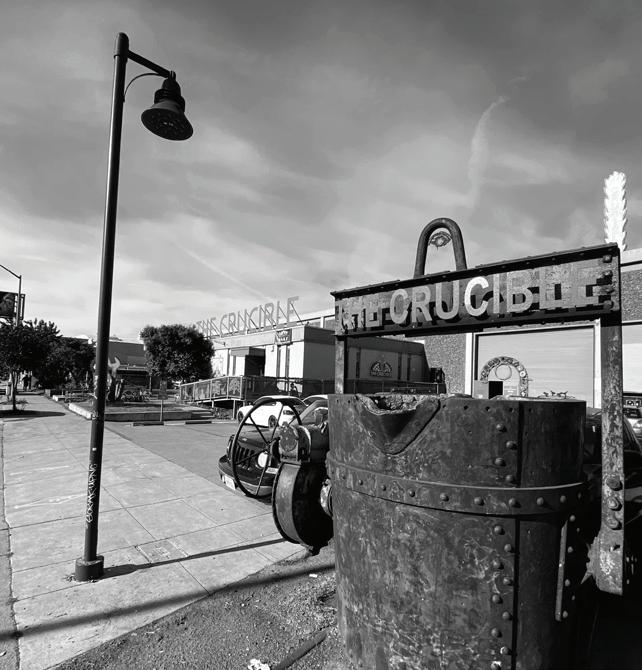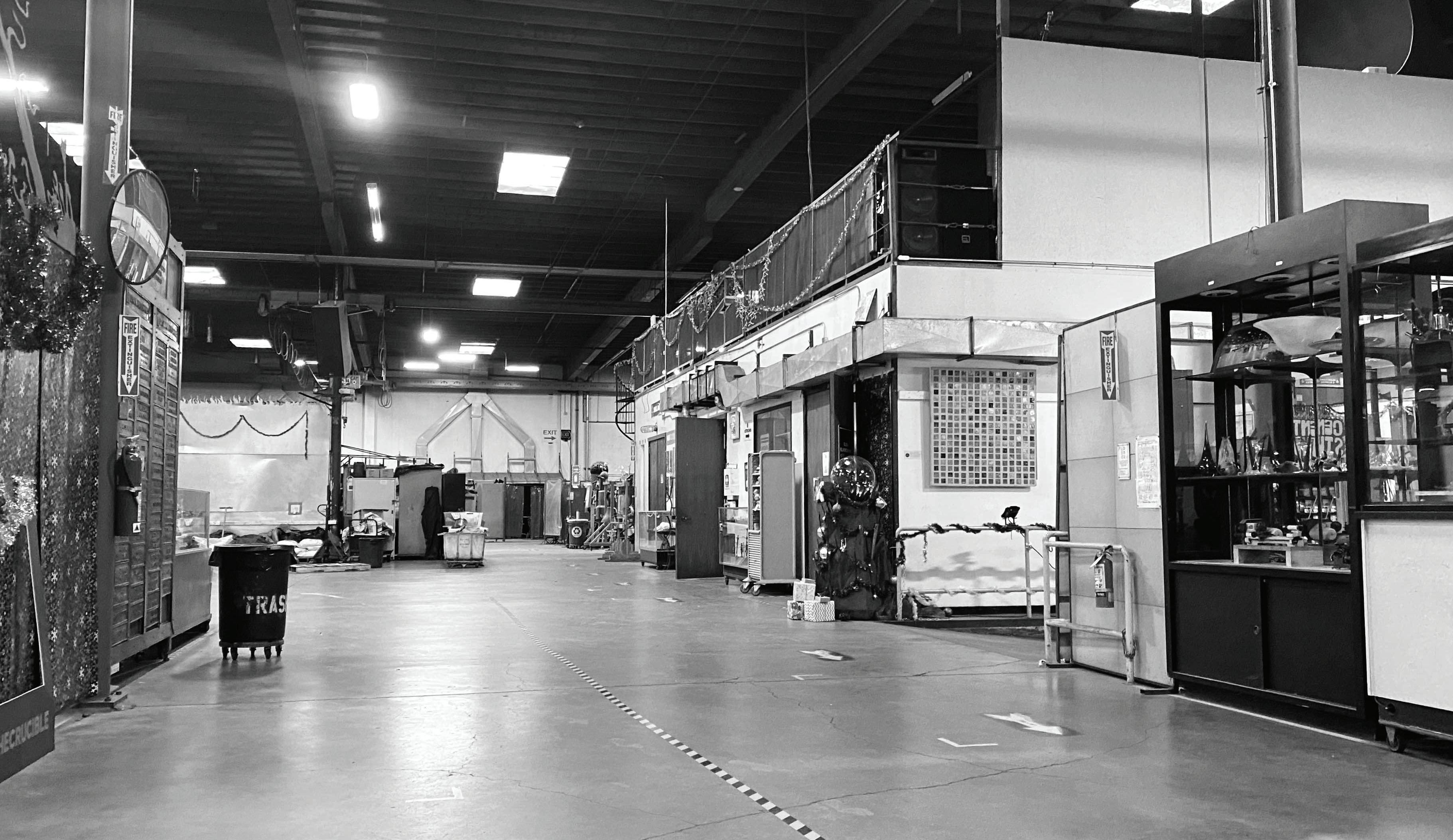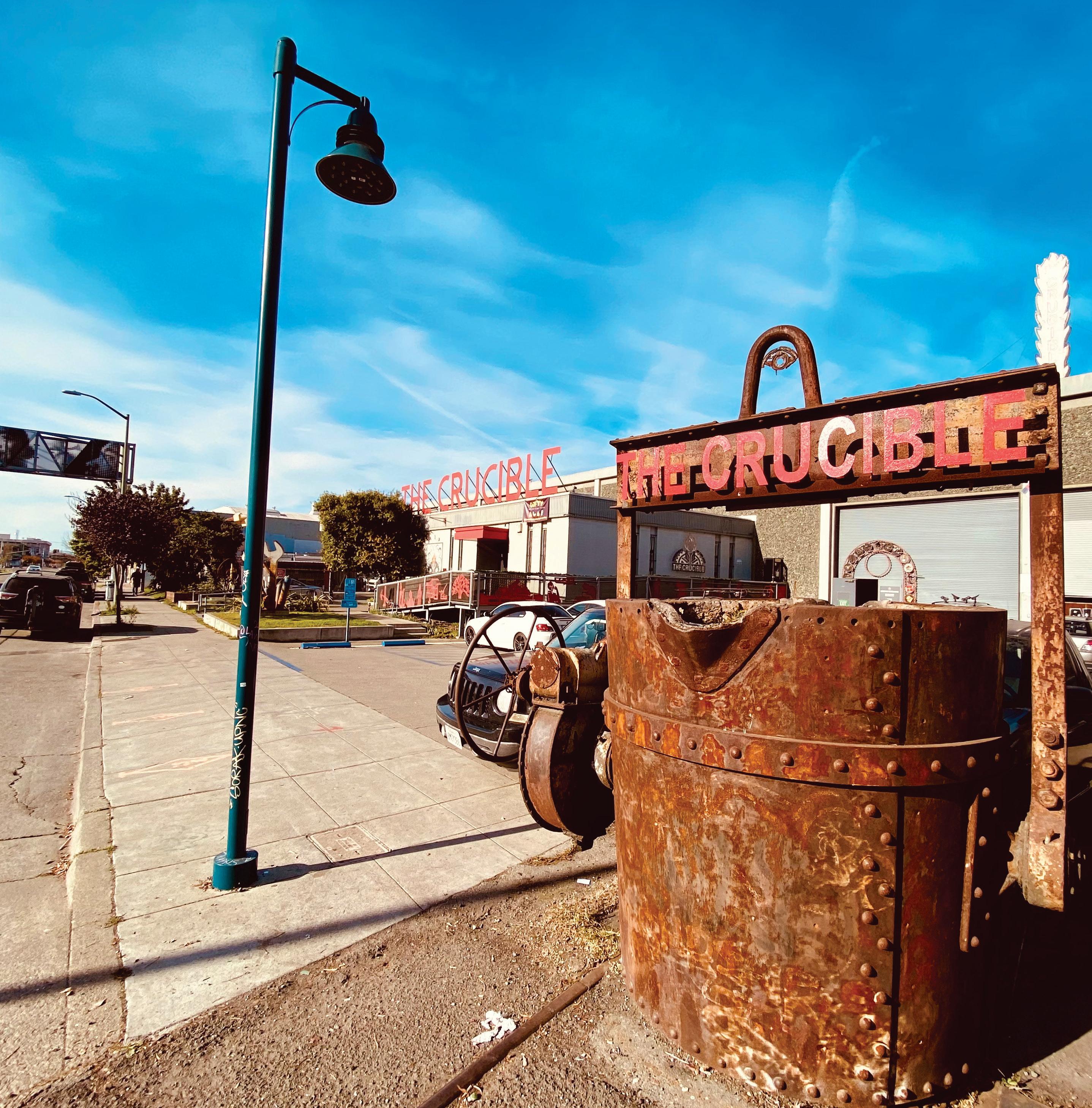
6 minute read
The Crucible fires up inspiration
The Bay Area’s preeminent industrial arts organization BY Mark Fernquest Fireon Imagination
Alifetime ago, when I was young and living in downtown Berkeley, I became aware of an interesting new metal-arts school in the warehouse district on the west end of town. I checked it out on several occasions, attending an open house and some wildly creative parties replete with fire dancers, metal pours, live music, sculpture gardens, artists and crowds of cool people. That new establishment called itself the Crucible, and it was a bright light in the local art scene. It comes as no surprise to me that during the 20-plus years since it opened, it has established itself as a nationally recognized, preeminent Bay Area arts institution.
Now long-located in a massive, 56,000-square-foot warehouse in West Oakland, just a block from the West Oakland BART station, the Crucible is, according to its website, “a nonprofit organization and art school dedicated to making the fine and industrial arts accessible for all ages, backgrounds and abilities.” With an award-winning faculty, over 19 different art departments—including welding, woodworking, jewelry-making and blacksmithing—and an average student-to-teacher ratio of 6:1, it annually offers over 900 beginner, intermediate and advanced classes to thousands of aspiring artists of all types.
The community ethos of the Crucible cannot be overstated. Arguably, it exists only in relation to the greater East Bay as a whole. Its events and performances, ranging from the Burning Man-influenced parties I attended in the early 2000s to Fire Arts festivals, operas and ballets in more recent years, make for wildly creative and festive weekend nights. But the Crucible also serves its surrounding West Oakland neighborhood, Oakland and the greater community in much more visceral and enduring ways—through its scholarships programs, youth camps and paid leadership opportunities, as well as the employment it offers »

MASSIVE The Crucible’s 56,000-square-foot warehouse space contains extravagant amenities including industrial-arts workshops, all manner of machinery and artwork, offices, rest rooms and vending machines.
»to local artists, the skills it teaches its students and its dedication to diversity, creativity, personal transformation and local economic development. Its Bike Shop alone is an institution unto itself, offering Fix-A-Thons, an Earn-A-Bike Program and Open Shop Hours—all of it free to the local community.
And yet, despite years of success, there have been obstacles. The most recent? Covid.
“Covid had a devastating effect on the Crucible,” says Executive Director Susan Mernit, via an email interview. “We had to close the building, and all of our teaching artists lost their income from teaching classes. We quickly pivoted to supporting them and staying afloat. We raised over $70,000 for an emergency fund that we distributed directly to our teaching artists, began helping our artists promote and market their art, and started a weekly free food pantry that continues to this day. We were able to get government support that allowed us to bring our staff back from furlough at the same or higher salaries than they had before.”
That actually sounds like a resounding success story to my naive ears.
With regards to the steps the Crucible has taken to remain safe during the ongoing epidemic, Mernit says: “As an industrial arts school, the Crucible
»has always been highly committed to creating a safe environment for our students. We follow the Alameda County Public Health Department guidelines for schools, as well as ... the Oakland Unified School District rules for youth who are unvaccinated. Upon entry, all students and guests must complete a health screening and temperature check, as well as show proof of vaccination or negative Covid19 test.”
Indeed, while visiting the campus to research this article, I was immediately impressed by the thorough healthscreening process each incoming student passed through.
The Crucible recently held its annual holiday gift show, GIFTY, the first weekend of December. Over 3,500 people attended, shopping directly from over 70 local Bay Area artisans and craftspeople. December events now past, what should we expect from the Crucible in the coming year?
“We are excited to be offering our week-long classes, starting Jan. 10, in areas like glass flameworking, ceramics, woodworking and more,” Mernit says. “Our Ceramics Department is doubling in size and adding wheel throwing. We will have nine operational wheels and a lot of other equipment to make these offerings successful!
“We have also had great success with our new Open Shop Hours in our Bike Department on Thursday nights, where youth and adults can visit the Bike Shop to learn how to repair and maintain their bikes for free. Based on that success, we will start some workshops on how to build bike trailers for local people who need them and some for Mandela Grocery to support their local delivery.
“We also have plans to relaunch our Glass Blowing and Glass Casting and Coldworking departments, which have remained closed for safety concerns since the beginning of Covid-19,” she adds.
Yet it is important to remember that while the Crucible is an integral part of the greater local community, it is also a community unto itself, consisting of faculty, staff, students, customers and event attendees such as myself.
“I have been lucky to be with the Crucible for the last four and a half years,” says Director of Marketing and eCommerce Natasha von Kaenel, via email. “I worked in media and as a marketing consultant before coming to support the Crucible’s Marketing Department, which I am now the head of.”
For her, “The Crucible is truly a community of students, staff and faculty who are excited about learning and developing fine and industrial arts skills while keeping them accessible for our neighbors and low-income communities. I feel lucky to have met so many incredibly passionate artists and students committed to meeting people where they are and exploring their creativity. In addition, as the head of Marketing, I get to interview youth students who have directly benefited from our free programming and see how the arts have significantly impacted their confidence and leadership skills.”
Students intersect the Crucible through many avenues. Katherine Chan first visited it during an open-house event and was so fascinated by the different department demonstrations that she ended up taking classes in blacksmithing, flameworking and ceramics.
“I recommend visiting for an Open House,” she says. “At Open Houses, the public can see our faculty demo in their disciplines, check out incredible artwork by our community and get discounts on all Crucible classes and merch.” In addition, “The 3-hour tasters are a fun way to learn a new skill and become a Crucible member for early availability to enroll in classes.”
Join the Crucible community in 2022 by attending an Open House, a free tour, a bike Fix-A-Thon or by taking a class. Conveniently accessible from the Nimitz Freeway/Interstate 880 via the Union Street Exit, and located less than two blocks from the West Oakland BART station, the experience is sure to add creative luster to your life. Expect to make new friends and new art, and to learn new creative skills.
The Crucible has come a long way since I first crossed its path, over 20 years ago—but so have we all. Maybe I’ll see you there.
The Crucible, 1260 7th St. Oakland. 510.444.0919. info@thecrucible.org
LOCALLY MADE The Crucible, the largest nonprofi t industrial arts education center in the United States, o ers classes in blacksmithing, ceramics, leatherworking, welding and more all year long.







